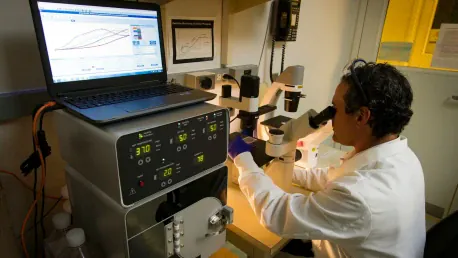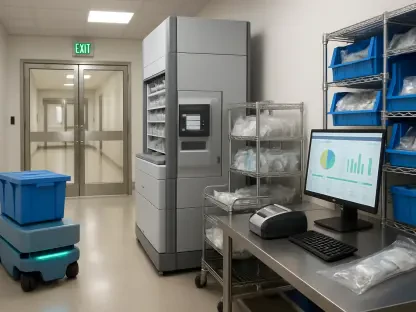In recent years, the medical device industry has made significant strides toward embracing sustainability. As the global focus shifts towards more environmentally responsible practices, top manufacturers are leading the charge, integrating eco-friendly initiatives into their business operations. This endeavor isn’t just about minimizing their environmental footprint; it’s also about aligning patient care with environmental health, reflecting a holistic approach to healthcare. Companies like Philips, Siemens Healthineers, Medtronic, GE Healthcare, Johnson & Johnson, Stryker, and Becton Dickinson are pioneering these efforts by embedding sustainability into their core strategies.
Philips: Pioneering a Sustainable Health Revolution
Comprehensive ESG Framework
Philips has set ambitious ‘Healthy People, Sustainable Planet’ goals, embedding a comprehensive Environmental, Social, and Governance (ESG) framework into its innovation process. This strategy ensures that every product created not only meets high medical standards but also minimizes environmental impact. Through initiatives such as energy efficiency improvements and the elimination of hazardous substances, Philips is reducing its carbon footprint and fostering a safer, greener environment.
Additionally, Philips’ ESG framework extends beyond product development to encompass the entire supply chain, ensuring responsible sourcing of materials. This approach involves rigorous assessments and collaborations with suppliers to maintain high environmental and social standards. By prioritizing sustainability at every stage, from design to end-of-life management, Philips is setting a benchmark for the industry, demonstrating that ecological responsibility and business excellence can go hand in hand.
Circular Economy Commitment
A significant element of Philips’ sustainability strategy is its commitment to a circular economy. The company refurbishes, recycles, or recovers parts from used medical equipment, extending product life cycles and reducing waste. This practice not only minimizes environmental impact but also provides cost-effective solutions for healthcare providers. By maximizing resource utilization, Philips is not only reducing its environmental impact but also promoting sustainable healthcare practices across the industry.
This commitment to the circular economy involves innovative programs and dedicated facilities for refurbishing medical equipment, ensuring high safety and performance standards. Philips’ efforts in creating a circular economy showcase their long-term vision for a sustainable future in healthcare. By fostering a culture of reuse and recycling, Philips is transforming the way the industry operates, emphasizing the importance of sustainability in modern medical practices.
Siemens Healthineers: Integrating Eco-Conscious Design
Resource Efficiency and Circularity
Siemens Healthineers places a strong emphasis on resource efficiency and circularity. The company integrates eco-conscious designs into its diagnostic and therapeutic imaging systems, focusing on reducing the carbon footprints of its operations. Siemens Healthineers champions initiatives such as using recyclable materials and optimizing energy consumption across their manufacturing processes, demonstrating responsible use of resources throughout product life cycles.
Their commitment to resource efficiency includes comprehensive environmental assessments at every stage of product development and stringent performance standards for reducing waste. Siemens Healthineers’ eco-conscious design approach sets a precedent in the industry, showing that technological advancements and sustainable practices can coexist. Their resource-efficient models not only help preserve natural resources but also offer cost savings and operational efficiencies that benefit healthcare providers globally.
Advanced Diagnostics and Sustainability
In its laboratory diagnostics segment, Siemens Healthineers is implementing multiple initiatives to enhance sustainability. This includes optimizing manufacturing processes to reduce energy consumption and waste, demonstrating their dedication to environmental responsibility. These efforts ensure that their diagnostic tools provide high-quality, sustainable solutions that meet the evolving needs of the healthcare industry.
Additionally, Siemens Healthineers is focusing on developing energy-efficient diagnostic equipment and investing in research for sustainable healthcare innovations. This dedication to R&D ensures that their products remain at the forefront of technology while adhering to stringent environmental standards. By championing advanced diagnostics and sustainability, Siemens Healthineers underscores the essential role of innovation in driving ecological and medical progress simultaneously.
Medtronic: Holistic Sustainability Strategy
Exceeding Industry Regulations
Medtronic’s approach to sustainability goes beyond merely adhering to industry regulations. The company actively focuses on reducing waste and energy consumption across its facilities, exemplifying a holistic sustainability strategy. Medtronic’s initiatives include implementing comprehensive waste management programs, enhancing energy efficiency, and adopting green building practices, which collectively contribute to their environmental goals.
By consistently aiming to exceed regulatory standards, Medtronic sets a high bar for industry practices. Their proactive stance on environmental stewardship involves continuous improvement and innovation in sustainability practices. This approach demonstrates their commitment to shaping a more resilient and environmentally responsible healthcare sector, ensuring that they address environmental challenges while maintaining high standards of patient care.
Hospital Collaboration for Eco-Friendly Practices
Another notable initiative by Medtronic is its collaboration with hospitals to implement eco-friendly practices. By partnering with healthcare providers, Medtronic ensures that its sustainability efforts extend beyond manufacturing. These partnerships can include initiatives such as waste reduction programs, energy-efficient technologies, and sustainable supply chains, fostering environmental responsibility across various touchpoints in the healthcare ecosystem.
This cooperative approach highlights the interconnected nature of sustainability within the healthcare sector. Medtronic’s collaboration with hospitals not only enhances their sustainability impact but also promotes best practices across the industry. By working together with healthcare providers, Medtronic helps to create a comprehensive network of eco-friendly practices, underscoring the collective responsibility in achieving environmental goals.
GE Healthcare: Innovation in Sustainable Imaging
Eco-Conscious Manufacturing
GE Healthcare is incorporating eco-conscious principles in the development of its medical imaging systems, targeting a reduction in environmental impact throughout the lifecycle of products like CT scanners. The company’s strategies involve adopting energy-efficient technologies, minimizing resource usage, and prioritizing sustainable materials in product manufacturing. These practices highlight GE Healthcare’s commitment to mitigating the environmental consequences of medical device production.
In addition to eco-conscious manufacturing, GE Healthcare employs advanced techniques to ensure that their products contribute to a healthier planet. Initiatives such as waste reduction programs and energy management systems help lower carbon emissions and resource utilization. By integrating eco-friendly practices in their operations, GE Healthcare not only supports environmental preservation but also enhances the sustainability of their diagnostic and imaging tools.
Additive Manufacturing Advantages
One of GE Healthcare’s innovative approaches includes the use of additive manufacturing to enhance sustainability. This advanced manufacturing technique allows for the efficient creation of medical device components, reducing waste and energy consumption. Additive manufacturing, often referred to as 3D printing, enables greater precision and less material usage, aligning with GE Healthcare’s environmental objectives.
The adoption of additive manufacturing technologies provides several advantages, including shorter production times, reduced material wastage, and improved design flexibility. These benefits contribute to the overall sustainability of GE Healthcare’s products and operations. By leveraging cutting-edge technology, GE Healthcare continues to push the boundaries of sustainable manufacturing in the medical field, setting new standards for innovation and environmental stewardship.
Johnson & Johnson: Balancing Patient Outcomes with Environmental Responsibility
Eco-Conscious Product Design
Johnson & Johnson (J&J) seamlessly integrates sustainability into its operations by focusing on eco-conscious product design. The company ensures that its medical devices are not only effective for patient care but also environmentally responsible. Johnson & Johnson’s dual focus on patient outcomes and environmental health exemplifies its commitment to holistic healthcare, aiming to deliver high-quality medical solutions while safeguarding the planet.
This commitment to eco-conscious design involves thorough assessments of the environmental impact during the entire product lifecycle. J&J’s initiatives include reducing the use of hazardous substances, increasing energy efficiency, and enhancing the recyclability of their products. Through these efforts, Johnson & Johnson sets a strong example of how sustainability can be incorporated into product innovation, benefiting both patients and the environment.
Comprehensive Manufacturing Practices
J&J’s sustainability efforts extend to its comprehensive manufacturing practices. By reducing environmental impacts through energy-efficient processes and sustainable material sourcing, the company aligns its production methods with broader environmental goals. Johnson & Johnson’s initiatives reflect a broader industry trend of embedding sustainability into core business strategies, ensuring that environmental considerations are integral to their operations.
These comprehensive manufacturing practices encompass a wide range of activities, including minimizing water use, reducing greenhouse gas emissions, and implementing stringent waste management protocols. J&J’s holistic approach ensures that sustainability is a fundamental aspect of their business operations, reinforcing their role as a leader in responsible medical device manufacturing. By integrating environmental practices into every aspect of production, Johnson & Johnson demonstrates their dedication to advancing healthcare while protecting our natural resources.
Stryker: Innovative Solutions for Waste Reduction
Sustainability Solutions Program
Stryker stands out for its innovative Sustainability Solutions program, which focuses on reprocessing and remanufacturing single-use devices. This approach not only extends the lifespan of medical devices but also significantly reduces material consumption and waste. Stryker’s efforts in waste reduction are setting new standards for sustainable practices in the medical device industry, illustrating their commitment to environmental responsibility.
Through the Sustainability Solutions program, Stryker reprocesses a wide range of medical devices, ensuring they meet regulatory standards for safety and effectiveness. This initiative not only helps reduce healthcare costs but also alleviates the environmental burden of single-use medical devices. Stryker’s reprocessing programs exemplify how innovative approaches can lead to significant sustainability gains, fostering a culture of reuse and efficiency in the healthcare sector.
Renewable Energy Investments
Investing in renewable energy is another core element of Stryker’s sustainability strategy. By harnessing renewable sources such as solar and wind power, the company is drastically reducing its carbon footprint. Stryker’s commitment to green energy demonstrates a proactive approach to environmental responsibility, positioning the company as a leader in sustainable medical device manufacturing.
These renewable energy investments span various operational aspects, including manufacturing facilities, corporate offices, and research centers. By integrating renewable energy into their infrastructure, Stryker not only reduces reliance on fossil fuels but also enhances the sustainability of their entire supply chain. This emphasis on renewable energy underscores Stryker’s dedication to creating a sustainable future while continuing to deliver innovative medical solutions.
Becton Dickinson Medical: Life Cycle Sustainability
Sustainable Medical Technology Institute
In recent years, the medical device industry has made notable progress in adopting sustainable practices. As global attention pivots toward more eco-conscious operations, leading manufacturers are at the forefront, incorporating green initiatives into their business models. This shift isn’t merely about reducing their environmental impact; it’s also about harmonizing patient care with environmental wellness, embodying a more holistic outlook on healthcare. Companies such as Philips, Siemens Healthineers, Medtronic, GE Healthcare, Johnson & Johnson, Stryker, and Becton Dickinson are driving these efforts by weaving sustainability into their fundamental strategies.
These industry giants are transforming their processes and products to reduce waste, enhance energy efficiency, and use more sustainable materials. Philips, for example, has committed to becoming carbon-neutral and has launched numerous green products. Siemens Healthineers focuses on energy-efficient medical imaging and laboratory diagnostics. Medtronic invests in low-impact manufacturing technologies, while GE Healthcare develops energy-efficient imaging equipment. Johnson & Johnson continuously improves its environmental sustainability through various initiatives, including reducing emissions and wastewater. Stryker and Becton Dickinson, too, are setting ambitious goals in waste reduction and resource conservation, demonstrating that sustainability can coexist with innovation in healthcare.









